Moroccan cuisine is renowned around the world, and one could say that at least cous cous has reached the tables of many countries, Italy included.
I must confess that I was very excited to try the food in Marrakesh's infamous main square, Jemaa el Fna, also called simply 'la place' in French. At night the UNESCO-listed square becomes very alive, with plenty of different stalls offering all sorts of different food, from meat skewers to fried vegetables, and even goat heads! I returned every night I was in Marrakesh, even though the quality of the food changed drastically, even at the same stall. If one night a certain stall had excellent calamari, easily comparable to the same dish in a very good restaurant in Italy, the following night the same dish was disappointing to say the least. Dishes cost 10-70 dirhams (€ 0,88-6), and they are perfect for sharing. The average price paid for a dinner was, in my experience, between 40-80 dirhams per person (€ 3,46-7).
 |
| Making friends in Jemaa el Fna |
One of the best pleasure of travelling in Morocco is drinking glass after glass of delicious freshly-squeezed orange juice. In Morocco orange juice is served everywhere, and it is inexpensive if compared to Europe. It costs 4-5 dh (€ 0,35-0,43) in Jemaa el Fna, and usually not more than 10 dh (€ 0,86) in a restaurant. In Italy it would cost me at least €2,50 in a bar!
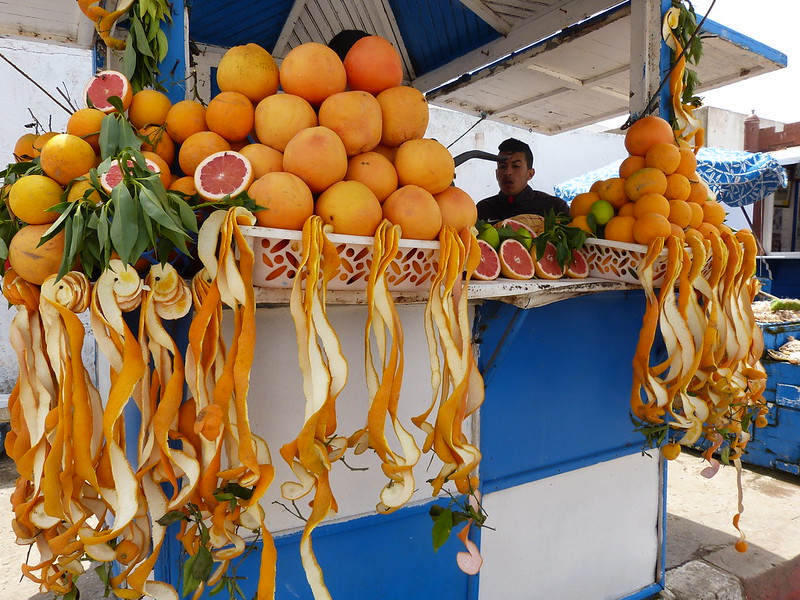 |
| Orange juice stall in Essaouira |
Morocco is a country that has a lot of fresh produce: olives, oranges, dried fruit and nuts, but also fresh fish along the coast, or camel meat in the interior.
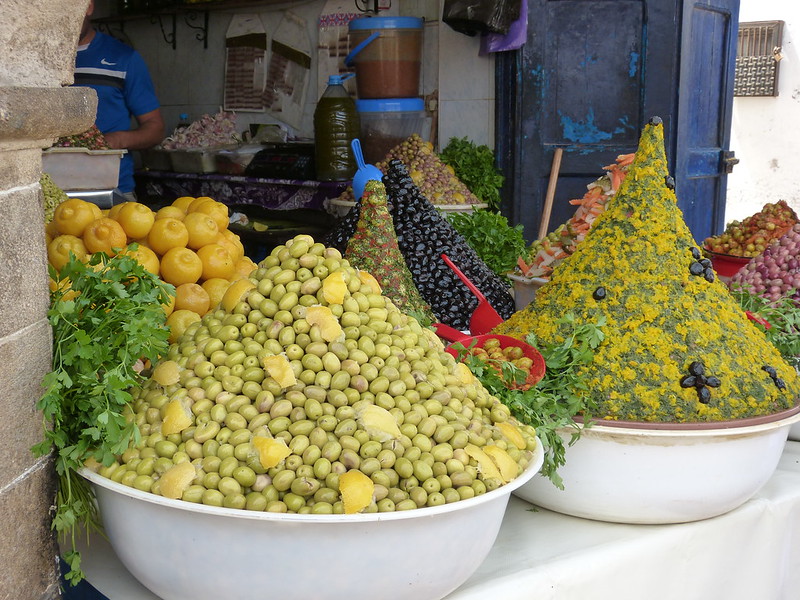 |
| Olives for sale in Essaouira |
Perhaps you'll be surprised to discover that the cous cous served in Morocco is not the same that you buy in supermarkets in Italy or in the UK. What we have is instant pre-steamed cous cous, but the original one takes a while to cook, and it's more fluffy. The traditional dish is often served with vegetables, without many spices. It is not even the most popular dish, at least in the part of Morocco that I visited. As a matter of fact, the protagonist during our Moroccan meals seemed to be the tajine.
A tajine is a traditional Berber dish that takes the name of the conical earthenware pot in which it is cooked. There are all sorts of colourful tajines for sale all over Morocco, but not all of them are good for cooking. The small ones that you often see and that could fit your hand luggage are usually for presentation or decoration.
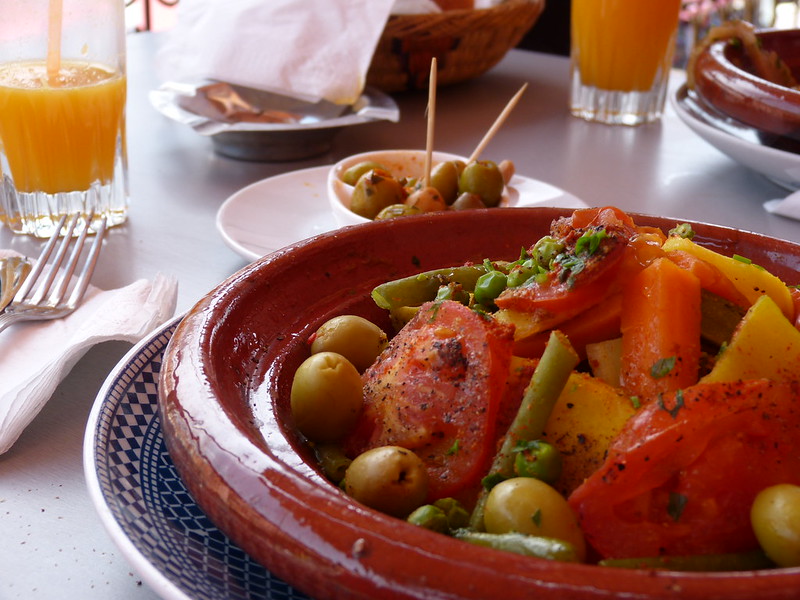 |
| Vegetable tajine with orange juice in Marrakesh |
On my third day in Marrakesh I decided to take a cooking class organized by my hostel. At 10 am I met with the other participants, an American couple who was as eager as I was to learn the secrets of Moroccan cuisine. Our instructors were Mariam and Aida, two young and smiling Moroccan girls who spoke very good English. We cooked a vegetable tajine and a beef stew with prunes and nuts, plus a delicious avocado milkshake with dates and nuts. I know the latter sounds strange to most of you, but I assure you that it was delicious!
We went to the market first to buy vegetables and meat. If you're squeamish, this might not be the place for you: flies buzz around huge cuts of meat, and rusty utensils re used to weigh the vegetables. In spite of this, it was fascinating to see how things were bought and sold in the old medina of Marrakesh.
Our next stop was to buy bread, milk, nuts and dried fruit for our dishes. The place they took us to was absolutely fascinating, a paradise for someone like me who loves all kinds of nuts. They also had many kinds of dates, whereas in Italy you can find only one.
It was very interesting to see how a very simple thing like peeling vegetables can be done differently in a different part of the world. The zucchini were peeled as you do with a potato for example, and they were of a lighter colour compared to the ones we normally use in Italy. The eggplant was also peeled, but only partially. I felt like a child again, learning the basics of cooking with my mother. There was a very relaxed atmosphere throughout the class, with the girls laughing at my crying while cutting the onions.
We disposed the vegetables in the bottom of the tajine: onions first, then potatoes, peas, zucchini and eggplant.
Our next stop was to buy bread, milk, nuts and dried fruit for our dishes. The place they took us to was absolutely fascinating, a paradise for someone like me who loves all kinds of nuts. They also had many kinds of dates, whereas in Italy you can find only one.
 |
| Mariam shopping for nuts in the old medina |
It was very interesting to see how a very simple thing like peeling vegetables can be done differently in a different part of the world. The zucchini were peeled as you do with a potato for example, and they were of a lighter colour compared to the ones we normally use in Italy. The eggplant was also peeled, but only partially. I felt like a child again, learning the basics of cooking with my mother. There was a very relaxed atmosphere throughout the class, with the girls laughing at my crying while cutting the onions.
We disposed the vegetables in the bottom of the tajine: onions first, then potatoes, peas, zucchini and eggplant.
 |
| Small tajines for sale in Marrakesh |
When it was the moment to add the spices, each of us took turns in sprinkling ginger, paprika, cumin, saffron, pepper and parsley. Those sachets in the picture is fake saffron, used to give colour to the dish. Apparently, it's very common in this part of the world to use fake saffron, because the real spice is very expensive, in spite of the fact that it is grown in Morocco.
 |
| Spices for our cooking class |
 |
| Cooking class in Marrakesh |
The tajine was left for 30 minutes on the stove, and then it was ready to be eaten!
This cooking class cost me 150 dh (13€), plus the money we spent for the food at the market, around 90 dh (7,80€) per person.
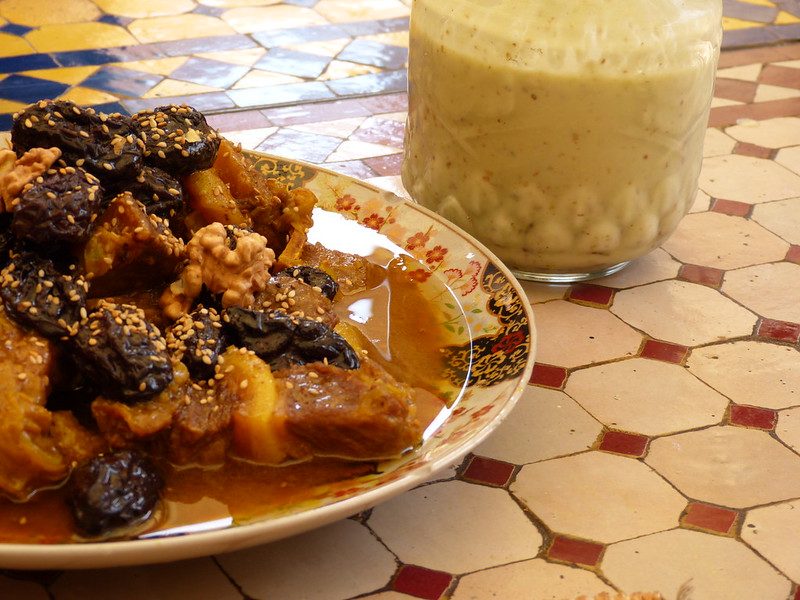 |
| Beef stew with prunes and nuts, plus the avocado milkshake |
One thing is sure: I'm going to prepare that avocado milkshake at home too! You need milk, an avocado, some dates, some walnuts, vanilla sugar, and regular sugar. They're all ingredients I can find in Italy too! Fresh juices were one of my favourite things in Morocco, and I had them in different places and with different fruit.
Not every experience I had in Morocco regarding food was excellent, though. During my 3-day trip to the Sahara desert, where we explored the region to the east of Marrakesh, the mini-bus (it was one of the many tours offered by my the hostels and riads of Marrakesh) often stopped in touristic restaurants in the middle of nowhere. All these places offered wi-fi, and a decent toilet, but the food was honestly not particularly exciting. They all offered the same menus: chicken tajine, vegetable cous cous, grilled keftas (meatballs), and skewers, with a poor selection of vegetables or a salad for side dish. They were also expensive for Moroccan standards: usually around 80-100 dirhams (7-9€) for a main dish and a drink. There were really no alternatives, as there were no other restaurants around, and I think it was intended to make us spend that money there.
I wonder if more expensive tours booked through other travel agencies offer you more appealing choices, or at least the freedom to choose where to eat. What I know is that a couple who I had met in Marrakesh and had booked a more expensive private tour also had lunch in one of these restaurants. This flaw of the guided tours to the Sahara region makes you think that there is little variety concerning food in central Morocco, which is probably not true.
The best meal I had in Morocco is perhaps that at the harbour in Essaouira. There are fish stalls that grill whatever fish you want at the moment for a ridiculous price. We paid 75 dh each (€6,60) for a big plate of fresh prawns, scampi, squid, sole, sea bass and sardines, served with salad, chips and a drink included in the price. Pay attention to the water bottle that you're served, because mine appeared not to be sealed, so I told them I had changed my mind and asked for a coke instead.
And you, have you tried Moroccan food? What is your favourite Moroccan dish?
 |
| Fish for sale in Essaouira |
And you, have you tried Moroccan food? What is your favourite Moroccan dish?

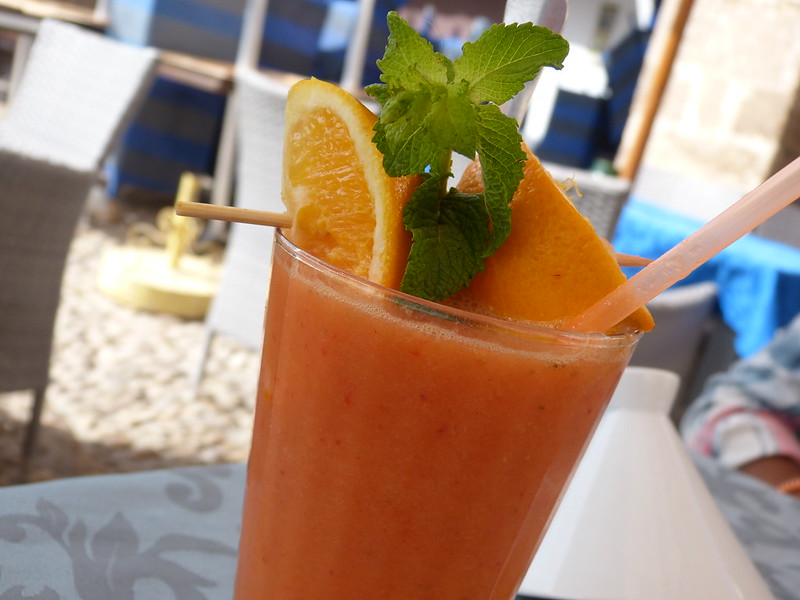
It looks delicious and exotic! For sure moroccan cuisine is one of the best of the world! I'm mad for couscous :)
ReplyDeleteHow funny you joined a cooking class! Must feel awesome to know how to prepare those delicacies at home too!!!
Yes, the cooking class was really fun, and interesting too!
DeleteFood looks awesome, and I also like the colorful crockery! So cool!
ReplyDeleteYes, I like that crockery too!
DeleteThis post has made me incredibly hungry! And I think that avocado shake sounds delicious (but then again I am an avocado freak!).
ReplyDeleteI almost couldn't read this post because I was so jealous! I'm so glad you had such a (mostly) good experience with food in Morocco! Annoying about the tours though.
ReplyDeletewow loving all the beautiful colors in the pictures and the food looks so good! great post!
ReplyDeletestyleandchocolates.blogspot.com
I lived in Taroudannt for half a year in 2012-2013, and I have to tell you that there really was not that much variety to Moroccan food! LOL! To be fair though, it's a very small, conservative city (just like Venezia but without the water, plastic gondole, and tourists!).
ReplyDeleteMy partner and I were the only foreigners who lived in the city, and it took some of the local traders in the souks several weeks to stop trying to fleece us! We eventually made friends with some of the stall holders, and always had a laugh with them when we went shopping for food... despite the fact that none of them spoke English or Italian, and we spoke almost no Berber, Darija, or Arabic - but were OK with French... which most of them weren't!
Did you have mint tea while you were there? And pastries/biscuits? Bliss! I really miss Moroccan tea.
Essaouira was much better for food variety than Taroudannt. We had a mini-holiday there in Jan.'13 - absolutely loved it. My favourite dish was conger eel tagine - absolutely heavenly!
I've only just discovered your blog but I shall be following it from now on! I see you've also been to Slovenia - that's where I'm currently living. :-)